#AG Frankfurt/Main
Explore tagged Tumblr posts
Text
Tiefgaragentor defekt: 50% Mietminderung
AG Frankfurt/Main, Urteil vom 12.07.2024 – 33052 C 89/24 1. Ein defektes und daher offen stehendes Ausfahrtstor der Tiefgarage stellt einen Mangel dar, der eine Minderung zu 50% rechtfertigt, da ein funktionierendes Tor ein Mehr an Sicherheit für die abgestellten Fahrzeuge gewährleistet. 2. Dies gilt ungeachtet dessen, dass es sich um eine Tiefgarage für eine Vielzahl von Fahrzeugen mit einer…
#33052 C 89/24#AG Frankfurt/Main#Eigentumsdelikt#Fahrzeuge#Funktion#Gericht#Mangel#Mietminderung#Minderung#Nutzer#Sicherheit#Tiefgaragentor#ungehindert#Urteil#Zugang
0 notes
Text

Wolf Vostell, Dé-coll/age Happening, (offset lithograph on paper), Rowohlt Verlag, Frankfurt am Main, 1966 [Walker Art Center, Minneapolis, MN. Fondazione Bonotto, Molvena (VI). © Wolf Vostell]
#graphic design#art#fluxus#happening#drawing#illustration#poster#wolf vostell#walker art center#rowohlt verlag#1960s
28 notes
·
View notes
Photo

Jacques Offenbach
Jacques Offenbach (1819-1880) was a composer of German birth who took French citizenship and became famous in Paris for his comic operettas, a genre he created, and for the more serious opera, The Tales of Hoffmann. A virtuoso cellist, conductor, and prolific composer of stage works, Offenbach was hugely popular across Europe through the 1860s.
Early Life
Jakob Eberst was born in Cologne, Germany, on 20 June 1819; his new family name of Offenbach was adopted later and derived from his grandfather's hometown of Offenbach am Main near Frankfurt in central Germany. His father, Isaac, was a leader of prayer and music in a synagogue. Jakob learnt to play the violin from age six and then the cello from age nine.
Jakob moved to Paris with his father and brother Julius in 1833. Jakob, now known as Jacques, was good enough to attend the Paris Conservatoire but he studied there only for one year. Living the bohemian life of Paris, his first job was in the orchestra of the Opéra-Comique. He paid for private lessons in composition from Fromental Halévy (1799-1862). In his spare time, Offenbach composed pieces for cello and piano, as well as a host of sentimental ballads, many of which were performed in salons in the French capital. Offenbach became best known as a virtuoso of the cello, but he also had a few waltzes played by the outdoor orchestra in the Jardin Turc. His career ticked along through the 1840s, but things took an upturn from 1850 when he became the conductor at the Théâtre Français.
Continue reading...
22 notes
·
View notes
Text
Watching the first ever episode of Tatort Stuttgart and I stand by my theory that if this had aired in mid 2010s to 2020s instead of 2008, this show would have been trending the way Tatort Saarbrücken (and on occasion, Polizeiruf Świecko/Frankfurt (Oder)) does.
It has - delicious height difference, a respectable age gap between the two main characters (who are consensual adults), whump, pretending to be a couple (a few times!!!) for a case, and if we're talking about how the characters have grown over the last 15 (or so) years, they could also count as Old Man Yaoi.
#people have been sleeping on Lannert and Bootz and I genuinely believe it's so unfair#also i have such the biggest crush on Thorsten#tatort stuttgart#sebastian bootz#thorsten lannert
19 notes
·
View notes
Text
The shapes of railway networks
A while ago @ariadsishereagain asked me about countries that have no railway networks, and what I think of them. That's a fascinating question that has been in my mind ever since, because the truth is you can tell a lot about a country and in particular it's history during the 19th and early 20th century by its railway network. So let's do that. And the best way to do that is by looking at the incredibly detailed open-source world railway map OpenRailwayMap, a part of the OpenStreetMap project. I really recommend it! And let's start with one of my favorite examples of how railway networks differ:

At this zoom level the site sadly only shows incomprehensible internal abbreviations rather than city names, so let me explain: What we have here are France and Germany, along with some of the UK and Italy, some of various neighbouring countries and all of Switzerland, Belgium and Luxembourg.
France and Germany are the ones that I find the most interesting, because the shapes of their networks are so different. Not only is the german one much more dense, but you can see completely different patterns.
In France, the job of railroads is to bring people to Paris (PLY, short for Paris Gare de Lyon) The lines stretch out into every part of the country, but almost all of them converge onto mainlines going into Paris. You can see some lines along the coasts and the borders, and there is a medium distances circle around Paris (passing MZ, DN, TO, short for Metz, Dijon, Tours). This whole pattern is known as the Legrande Star, after Baptiste Alexis Victor Legrande, the french government official who designed it. His goal was to provide great access to Paris, the nation's undisputed political, cultural and economical centre. A couple of decades later, Charles de Freycinet added plans to connect all departments to the railway network, but he still followed the idea that the ultimate goal of almost every rail line was Paris. And so it was, and largely remained. Even the high speed lines, in red, follow this pattern to this day.
A result is that you will have to go to Paris whether you want to or not. Lille-Strasbourg? You're going through Paris. Bordeaux-Dijon?
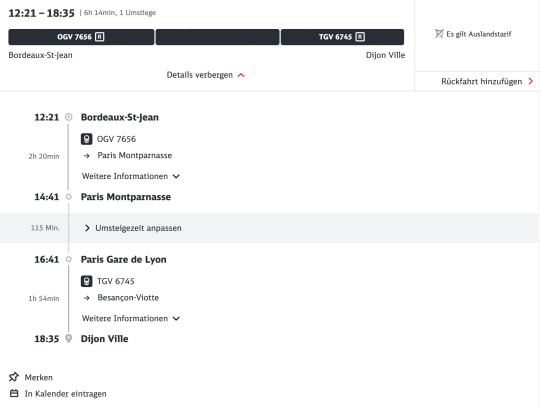
You're going through Paris, and get to make your own way from Gare Montparnasse to Gare de Lyon on the Metro (and it isn't even a direct metro, you have to change trains). It's a massive detour but it's not like you have a choice.
Even if there is a direct TGV or a connection outside the main stations of Paris, you're still ending up very much near Paris; the difference is just that you're not going via the city centre, but rather via Disneyland. Legrande wanted to bring people to Paris; he was less concerned about connecting other places with each other.
Now compare Germany, and you will see a network that is more dense, but most importantly, utterly chaotic. You can see hints of a France-like star around Berlin (BSPD, short for Berlin Spandau, which isn't the most important station but what can you do), but it's really only dominating its immediate surroundings, the region of Brandenburg. You can see vague hints of a similar star around Hamburg (AH; don't ask) or Munich (MH), but also a massive tangle around the Rhine-Ruhr industrial area (around KD), or around the Frankfurt am Main area (FF). Red high speed lines are essentially random. Some of them do go to Berlin, sure. But many, like the one from Cologne to Frankfurt (KD to FF) or the one from Hanover (HH) south, do not.
And that really reflects the history. Germany wasn't a unified country when railroad construction began, and even though it did unify shortly thereafter, there's no hiding that its different parts developed separately, with no central planning, ever since the middle ages. Germany doesn't have a single central city like France. Berlin is the biggest and most important city, but not by far. Hamburg has huge cultural and industrial influence, Frankfurt is the most important financial centre and airport, Munich is huge, and there are agglomerations like the Rhine-Ruhr region that used to beat all of them in terms of industry. And the rail network, with no single central focus point, reflects that.
That doesn't mean Germany doesn't have its own blind spots. Due to being split in two, the east-west links aren't great. Getting e.g. from Cologne (near KD) to Dresden (DH) is pretty painful. Ironically, Berlin is one of the places that really suffers from this. There are plenty of trains to it from Cologne but they take forever, and you can see why: A lot of the route isn't high speed, it's just more or less upgraded normal lines. If you have a single destination, then it's easy to build all the lines there. If you want high-speed connections between everything, that's more difficult. (Also, our government isn't investing anywhere near enough into the rail network, both compared internationally and on its own terms, but that's a different issue)
Other countries in Europe tend to be somewhere between the extremes. Spain is fairly centralised around Madrid.
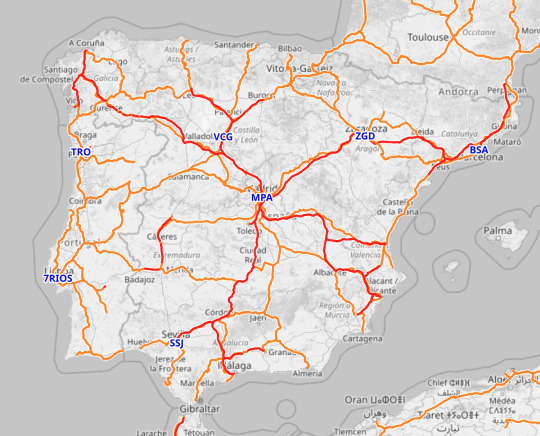
The UK is just as focused on London as France is on Paris, but it has strong regional networks around Leeds and Sheffield, and the weirdness in Scotland (four different lines between Glasgow and Edinburgh and counting!).

Italy, especially south of the Po valley, almost looks like a ladder: Lines are either on the one side of the Apennines or the other, with a few brave ones crossing through.
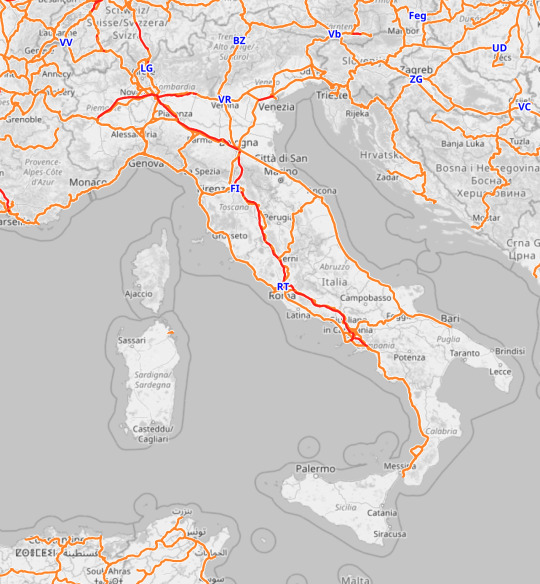
This works overseas as well. Describing the continental US as "like Germany" is certainly going to raise some eyebrows, but the map doesn't lie:

It's all on a completely different scale, but it's also a federal country with no one single clear centre. Yes, New York and Los Angeles are big and important, but neither is an all-powerful centre of the nation. What's fun about the US is that it's almost gradient-like: The more west you go, the fewer the railroads get. You can also nicely see the Alleghenies by the shadow they cast: Just a few brave rail lines managed to make their way through or around. Other characteristic items are the huge tangle that is Chicago, the closest thing the US has to a railroad capital; and the many places where lines are almost duplicated (just count how many different ways you can get from Chicago to Memphis, or Chicago to Cleveland), thanks to different competing railway companies that all hated (and sometimes still hate) each other's guts.
So that's what's mostly considered the "western world" or "industrialised world". I skipped Japan, China and India because the post is going to get too long no matter what, but they're all fascinating as well.
But if we go away from there look at countries where the colonialism was less settlers and more exploit mostly from afar, we see another very odd pattern emerge, like here in sub-saharan Africa:
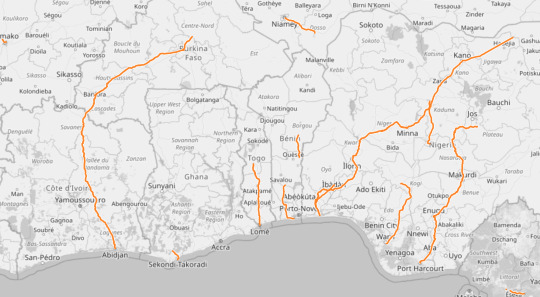
The selection is somewhat arbitrary because you can find the same pattern everywhere south of the Sahara, and in one case (Mauretania) even in the Sahara: A railroad that goes straight to the coast. (The isolated sections inland are due to issues with the map software, they're all connected to one of the lines to the coast)
This kind of railroad is designed to extract a country's resources, and not much else. In Mauretania (not in this picture), that's iron ore. Elsewhere it might have been other ores, precious metals, gemstones, but also very often agricultural products, spices, dyes. The railway line exists to take these things, and bring them to a port. The line is not designed to actually help the nation grow economically. Think about it: All things being equal, you're probably just as likely to want to go parallel to the coast as perpendicular to it.
Also, each of these lines were built because there's something interesting at the end of it, or at least someone suspected there might be. If you wanted to develop the area, it would make sense to trade the interesting stuff in Togo with the interesting stuff in Benin. But the railway lines are not set up for that at all. The goal is to get the interesting stuff to a ship, and occasionally soldiers to the place where the interesting stuff comes from.
These days, the area that I screenshotted here is actually massive, full of people. The city of Abidjan has more than four million inhabitants (more than Berlin), Lomé has 1.7 million, Cotonou and Porto-Novo come close to a million if taken together, and nobody's quite sure about Lagos, but it's at least 14 million, and the metropolitan region might be 24 million. This is a band of cities that researchers think might, in the next few decodes, become on par with Washington-Philadelphia-New York-Boston in the US, or the Tokyo-Osaka in Japan.
And the rail connections in this region do not reflect this at all. A high speed passenger line and/or a heavy duty freight line could allow all these places to do business with each other, allow people to move to or visit each other, and just spur a lot of economic development. But the powers that built the lines, the colonial powers, were not interested. They had their harbour, and the region behind it, and they just wanted to extract whatever was there.
To be clear, that does not mean the railroads are evil now. Selling natural resources is still better than bringing no money into the country. And there are a lot of places where railroad junctions and depots became the point where cities were founded, so in some countries these lines do end up connecting the most important cities, more or less by accident. It's just that other lines or more lines are sorely missing.
A simple example for how this could look like is provided by Australia, where the colonists were settlers and did want to develop the land economically:

You have the lines from the coast inland, and sometimes quite a lot of them. But you can also see a line along the east coast, connecting the cities, and you can see that someone said "we need to build a railroad across the entire continent. No, two actually". That is not to say that Australia does everything right with railroads, they have a lot of weirdness there. But you can see that the railroads had more jobs than to just move resources to ships.
(The big exception is the Pilbara region, in the north west, with its odd tangle of lines. Those are all just resource extraction lines, where the world's heaviest freight trains haul iron ore from various mines to various ports. The mines and ports are owned by different mining companies that don't like each other, so everybody has their own line from their own harbour to their own mine, even if a different line would have been shorter. That's why you get the tangle there.)
So, that's basically it. The railroad map of a country shows you a lot about how a country works, and more specifically how it worked during the late 19th and early 20th century, when most railroads were built. Where they lead to and where they don't reflects what planners thought of as important, and in turn, it has shaped the way these countries developed. And personally, I always find this endlessly fascinating.
#railroads#maps#i suppose you could take the 6 to bercy and walk from there but it's still not exactly convenient
300 notes
·
View notes
Note
https://www.tagesspiegel.de/sport/olympia-heldin-und-olympia-heldin-ann-katrin-berger-ist-fussballerin-des-jahres-12253841.html
Goalkeeper and Olympic heroine: Ann-Katrin Berger is footballer of the year
Goalkeeper Ann-Katrin Berger receives a high award - and criticizes: "They no longer want players aged 33 in the European leagues."
From former cancer patient to penalty hero at the Olympics and now Germany's footballer of the year: goalkeeper Ann-Katrin Berger has won the vote organized by "Kicker" for the first time and is the successor to Alexandra Popp. "I never expected that and had to digest it first. It's a nice feeling," said the 33-year-old from the US club NJ/NY Gotham FC. "It's very rare for goalkeepers to win titles like that.
The only goalkeeper to receive this award so far was Silke Rottenberg in 1998. Second behind Berger (144 votes) was Giulia Gwinn from FC Bayern (71). Third place went to Lena Oberdorf (66), who moved from VfL Wolfsburg to Munich and was absent from the Olympics due to cruciate ligament surgery.
Berger had only been promoted to number one by interim national coach Horst Hrubesch at the Olympic Games in place of long-time regular goalkeeper Merle Frohms. He enabled the Swabian-born player to have a dream tournament - after very difficult times: Berger had been diagnosed with thyroid cancer twice in recent years - most recently in 2022 during the European Championships. Both times she was back on the pitch within a few months.
Berger had to overcome “many obstacles”
“Anne is not only a strong goalkeeper, but also an impressive personality who has had to overcome many adversities and has always fought her way back,” praised Hrubesch.
Berger says she experienced her "happy ending" at the Olympics: in the quarter-final against Canada, she saved two shots in the penalty shootout before taking the penalty herself and scoring. In the match for third place against the world champions from Spain, Berger saved a penalty from Alexia Putellas in the ninth minute of injury time. She thereby secured the German team a 1-0 win and the coveted bronze medal.
No guarantee of Wück’s regular place
"I just wanted to play football again. I knew I wasn't finished yet," said Berger. The former Chelsea FC, Paris Saint-Germain and Turbine Potsdam player combined the late appreciation with criticism: "You have to say it clearly - and I experienced it myself - they don't want players at the age of 33 in the European leagues. Then you're apparently no longer good enough." It's completely different for goalkeepers, but apparently that's the case in women's football.
Despite her late rise, Hrubesch's successor Christian Wück has left the question of who the future goalkeeper will be open. "For me there are two number ones," said the 51-year-old at his presentation on Friday in Frankfurt am Main. (dpa)
11 notes
·
View notes
Text




Ottilie W. Roederstein - Self Portrait (1904 & 1926) | Dr. Elisabeth Winterhalter (1888 & 1902)
Born into a German merchant family in Zurich in 1859, Ottilie W. Roederstein initially met with opposition from her parents to become a painter. At the age of 17 she was allowed to take painting lessons with Eduard Pfyffer (1836-1899) in Zurich and later with the renowned portrait painter Karl Gussow (1843-1907) in Berlin. In 1882 O. W. Roederstein settled in Paris where she refined her mastery of portraiture as well as nude painting– a field of activity still largely taboo for women artists.
In 1891 O. W. Roederstein settled in Frankfurt am Main with her partner Elisabeth H. Winterhalter, a gynaecologist from Munich. The painter was able to establish herself quickly in the conservative metropolis on the Main.
Large solo exhibitions in Zurich and Frankfurt am Main in 1925, 1929 and 1934 brought O. W. Roederstein substantial recognition and she was also awarded several honours. In addition to her successful career as a painter, O. W. Roederstein was a patron of the arts and, together with her partner, also promoted education for women. After her death in 1937 the artist, who was highly regarded as one of the leading female portraitists of early Modernism, lapsed into obscurity. Her multifaceted oeuvre is now being rediscovered. (source)
73 notes
·
View notes
Text
Welcome Home A.R.G Crackcanons

Wally definitely feigns innocence because he’s the main character who has to “learn” with the audience
It’s canon that he thinks he’s handsome and enjoys admiring himself in the mirror, so he 100% knows about the simps and is super smug about it
With his soft voice and gentle demeanor, he really fits the “darling” reputation
Despite this, I do genuinely believe he’s a good person and means the best. My personal theory is that Home is manipulating Wally in some way to do their bidding.
(I picture Wally being manipulated by Home is a euphemism for paternal manipulation and depression. But that’s just a theory. A GAME THEORY-)
He strikes me as someone that everyone WANTS to be submissive, but is actually a very dominant
Barnaby and Frank have a SpongeBob-Squidward relationship
Barnaby goes out of his way to annoy Frank
Frank can respect the effort, but would never admit it
Barnaby calls Frank “Frankfurter” much to Frank’s dismay
Barnaby is Sans from UnderTale I don’t make the rules
A very easy-going, morally grey kinda guy. Super chill person who’s always down to have a good time.
He rarely gets embarrassed or flustered. Nothing really catches him off guard
Except anything having to do with romance. If someone flirts with him his brain short-circuits
Which is funny considering he’s definitely one to flirt with someone jokingly
He gives everyone in town unique nicknames
Barnaby has a lovely singing voice. He mostly enjoys singing jazz. But mostly he sticks to stand-up comedy
Howdy is Barnaby’s biggest fan
Howdy has control over the store radio and whenever there are no customers, he turns on hardcore rock. But you’d never know because he wears the same smile no matter the situation
You’d think that with all those legs that Howdy would be a klutz. On the contrary, he’s quite elegant and light-footed
Julie isn’t a klutz either, but she’s super forgetful. Head-in-the-clouds kinda person
Despite this, she always remembers the tiniest details about the most random things (ADHD lookin’ ah)
She’s definitely someone to collect rocks that she thinks are cool or feel nice on her hands
Her love language is touch but she hates being touched without permission
This leads to a few disputes between herself and Frank
Frank is the opposite tho. He acts like he hates being touched but he’s touchstarved
The only people allowed to touch him are Eddie and Julie
Sometimes Barnaby tries to touch Frank in subtle ways just to annoy him. (Such as noogying his head or poking his sides)
Frank LOVES bouncy, squishy stuff. It just scratches his brain just right
On the other hand, he HATES stuff that sticks to him.
For example, I imagine he’d be head over heels at the discovery of oobleck but would steer clear of glitter or anything that clings with static electricity
Because of the mentioned above, Frank has a VERY specific taste in clothing. He just hates the feel of certain fabrics
Knew he was in love with Eddie when the mailman was running to him happily, mail in hand, only to trip and face plant in the mud. Despite this, Eddie didn’t stop smiling
Himbo makes tsundere heart go brrrr
Neither one confessed to each other for AGES so Julie took it upon herself to put them into awkward situations
Cue Poppy “intervening”
Speaking of Poppy, she’s the resident mom-friend. Makes sure everyone’s taking care of themselves physically and emotionally
Despite this she always forgets to take care of herself
Poppy is SUCH a proud LGBT+ mom. Her house is a safe haven for the gays. I don’t make the rules
She’s a tall, elegant, lady, so she swoons at gentle ladies trying to sweep her off her feet
Literally such a sweetheart I love Poppy
Whereas Frank knows all the technical and sensical facts, Poppy is more worldly and wise. She’s been around the coop, so to speak
Im convinced Poppy knows everything about EVERYONE and spreads gossip just for the benefit of her neighbors
(For example she spread rumors that Frank was going to her house to get an engagement ring for Eddie. This wasn’t true, but it lead to both Frank AND Eddie barging into her house for an explanation. She simply placed two cups of tea and a tray of cookies and left them alone in the living room)
Barnaby likes to call her “Cupid” because of this
Poppy always shows up to one of her Neighbor’s events, whether it’s a show for Barnaby or a casting call for Sally
Sally loves the support of peacock mom
Sally writes all her own plays, but makes money by sending in her own transcripts under a pen name
She’s actually very famous under her pen name and is torn between revealing herself to the world and staying mysterious
Sally decides to remain anon so that she can focus on her acting
Spent years in the night sky, watching all the people in town and all their shenanigans. Many years passed before she could work up the courage to come down to introduce herself
Incredible actress, but she has social anxiety and is much calmer outside of a play
Adversely, once she’s got an idea, she’s ALL IN. All her brain cells go into that ONE project or idea, and she ends up dragging everyone along with her. A one track mind, if you will
Sally always casts herself as the lead, but if there are any other main characters or main antagonists she ALWAYS casts Wally to play the part
This low-key offends Barnaby, because he loves a good villain and always wants to play the part of antagonist
Sally always asks Julie to help her make the backdrops
All of the neighbors have fears of some sort, except for Wally
It’s kind of freaky that he never seems to give people the reaction their looking for
But ye Wally has emotions, he’s just INCREDIBLE at masking them
Wally loves eye contact because he believes that eyes are the window to the soul
It’s also an assertiveness thing but no one would ever guess cuz of his cutesy face
Wally def has a staring problem but smooth-talks his way out of any awkward situation that could come from it
Wally is demisexual. Though he loves people easily in the friendly sense, it takes a LONG time for him to fall for someone romantically. But once he does, it’s over for his love interest cuz he’ll become clingy AF
Barnaby is the opposite. He’s very in tune with his emotions and knows immediately when he likes someone. He just chooses to avoid the crap out of them as soon as he realizes. He just gets too embarrassed. I personally headcanon him as asexual
Julie is genderfluid and very similar to Wally. Though she isn’t demi, she loves all kinds of people equally. So it just takes a minute for her to decipher whether or not she loves someone NORMALLY or MORE than a friend.
Poppy is a classy lady who’s looking for a fellow lady to spend her life with. Since she’s got some experience, she’d probably take pride in playing the waiting game. Some subtle touches here, some lingering eye contact there… it’s a slow burn ladies and gents.
Frank is someone who prefers men (specifically Eddie. Good thing the feelings mutual.) likes his men dumb and well meaning.
Eddie prefers men as well. Specifically men who are serious and well read.
Howdy is pansexual, but isn’t really looking for a relationship due to his business.
Sally feels kinda like another asexual to me. But she’d like to be in a relationship with a friend. Like get married and share a life together without all the romancey stuff
Julie and Frank both have the same love language - physical touch. But in different ways as said earlier
Frank also prefers Acts of Service, like Howdy
Poppy enjoys gift giving
Sally and Barnaby enjoy words of affirmation
Wally is a casual Quality Time enjoyer
#lmao bye#ijustthinkhe'sneat#i love him dearly#welcome home#welcome home arg#wally darling#julie joyful#frank frankly#barnaby welcome home#howdy pillar#poppy welcome home#headcanon#crack#crack post#what am i doing
127 notes
·
View notes
Text
Notes on "Ambidextrous Angle" here
Notes on the flowers in ep.8 here
Notes on the colors in ep.10 here
Notes on the numbers on the car plae of No.3 and KMC here
Is justice really blind?
In the drama we have been introduced to the "Lady Justice" several times by now and she in fact takes a very important role in it, even if only in the background.
And throughout the drama, there are a handful of scenes where the characters question "why is she blind(folded)" and we also see pictures of her in KSJ book which depicts her blind version. We can see this very clear by one of the last scenes in ep.8 where KMC picks up the book from his table and flicks through the pages followed by a flashback of KSJ saying "This always bothered me. Lady Justic wears a blindfold because she's afraid of bias in decisions"
But is this really historically and mythologically accurate? Was "Lady Justic" (who btw goes by so many more names) really blindfolded? And if so why?
This post while explain:
The location and date of build of the Lady Justice depicted in KSJ book
Why the location/date is important
Depictions of Justitia
What did she really look like? What are her origins?
The meanings of her three (Actually 5) distinct features
How does it relate to the drama?
First of all, lets adress the Lady Justice' depicted in KSJ book. On of them- the one circled- is a statue of her located in the Old Town of Frankfurt am Main, Hessen, Germany. Below, there is a better photo of her exact location.


The Justitia statue fountain is a fountain called the "Gerechrigkeitsbrunnen" sculpted by Friedrich Schierholz in 1887. Its a replica of a fountain sculpted in 1611 (which again, was also a replica of a fontain built in 1543). The 4 virtues depicted below Justitia are:
Iustitia (Justice)- with sword of judgment and balance.
Temperantia (Control)- Moderation, distributing a liquid between two pitchers.
Spes (Hope) with a dove on her arm.
Charitas (Charity) with two children, one of whom she is breastfeeding.

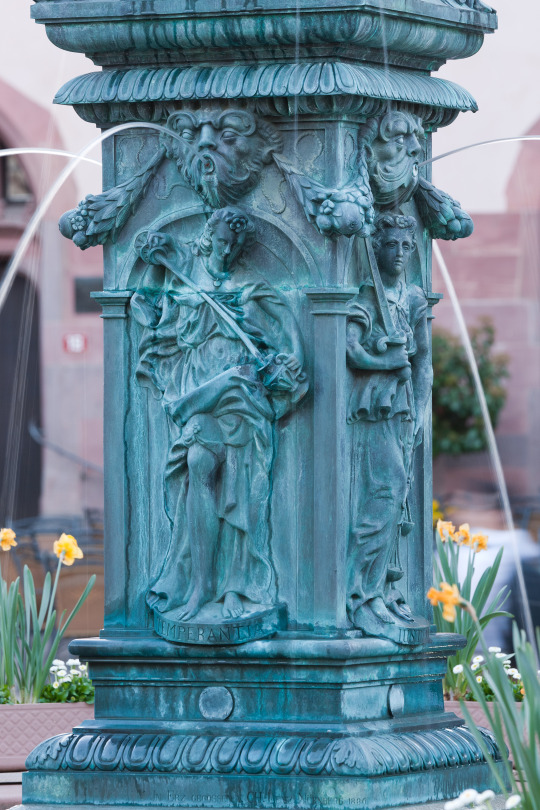
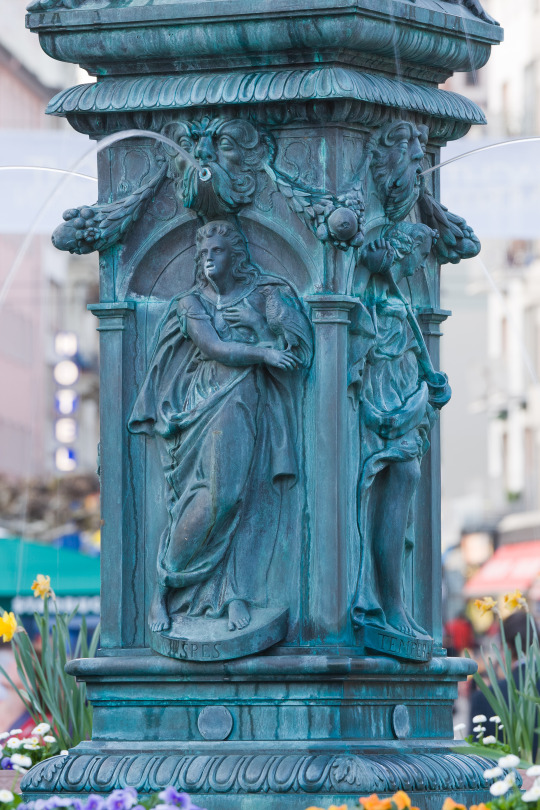
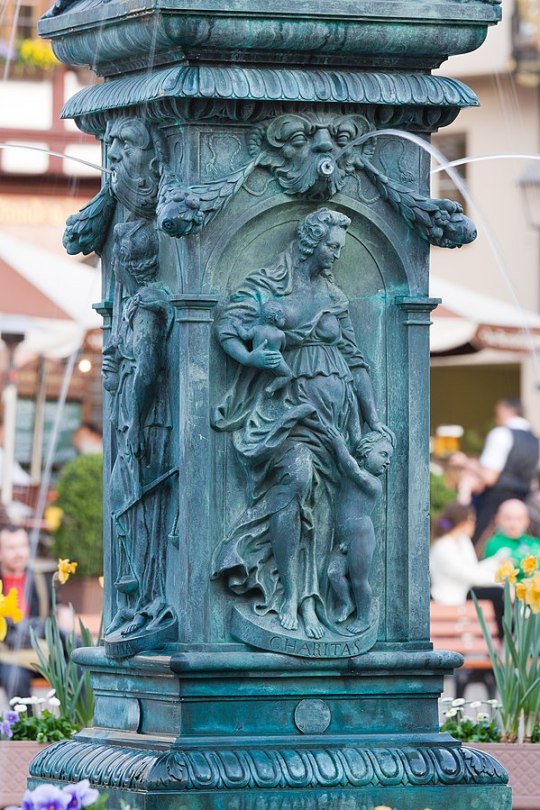
Why is the exact location or more date when she was built important to the question of "Is she really blind(folded)?"
Because, when the fountain was build, only then the whole myth of "Justice being blind" started.
It actually dates back to the mid 15th century where it first started as her being one eyed, then suddenly she was blindfolded. And the first known representation of her being blind is Hans Gieng's statue on the Gerechtigkeitsbrunnen in Bern, Switzerland built in 1543.
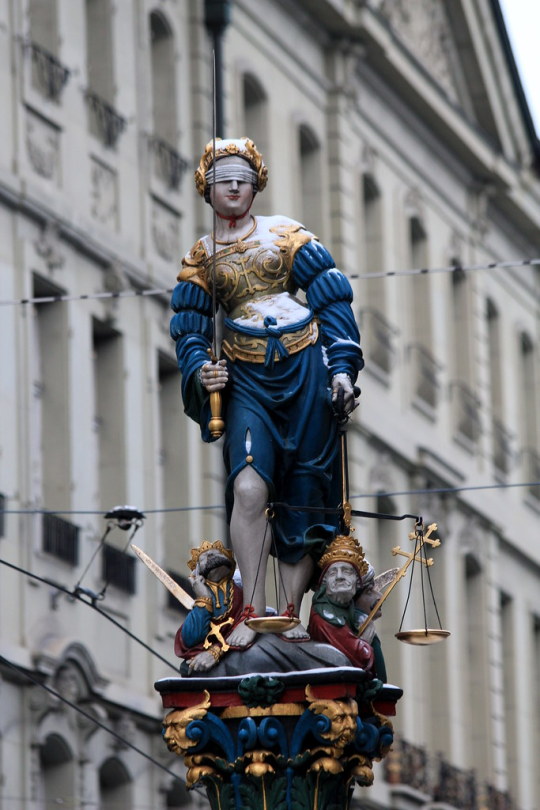
Different depictions of Justitia throughout the years/centuries.
There exist several renditions of her and they all changed over time. One source tells about a mortuary temple in egypt, honoring Pharao Ramses the Great. And it is said that in this temple there is a scene depicting judgment wher the associate judges had no hands and the presiding judge had closed his eyes. And from this, another depiction of Lady Justice developed in the middle ages: Justice, depicted as a woman, blindfolded and without hands. The sources then say "she has her right eye closed so that she doesn't recognize neither friends or rich people. And she has her left eye closed so that she doesn't recognize the poor and enemies (of the judge). With it, she doesn't judge by personal bias. And she doesn't have any hands either so she cannot accept bribes."
Which means, two versions - Justitia without hands and blindfolded, and Justitia with hands and blindfolded- coexisted then at the time.
In the late middle ages, both depictions started to merge. But this bears the question: If no hands, how can she hold the scale and the sword? In one of the older depictions of the "Combined Justitia" in the Lawbook of the City Eisenach, Thuringia, Germany- there she is with only one arm, holding the sword, while the scale is placed on the stump of her arm. At the same time, one of her eye is covered while the other isnt.
This later resulted in Lady Justice being blindfolded on both eyes.
But why was Justitia suddenly blindfolded? There is no exact answer to this question, only theories. One says "it seems to have been added to indicate the tolerance, or ignorance to, abuse of the law by the judicial system."
But how did roman/greek Justitia originally look like? What are her general origins?
"Lady Justice" was originall not blindfolded (and also not blind), and because of her "maidenly form" is supposed to guarantee her impartiality which renders the blindfold completely redunant.
In original iconographies of the ancient roman times Justitia was never blindfoded. She only held a sword and as scale, wore something akin to a crown and her Toga (more on these things down below)
Her origins date back to the ancient roman time (or greek, if we follow her greek counterpart Dike) and roman mythology where she was introduced by the emperor (Caesar) Augustus- and thus not a very old deity of the roman pantheon.
Justice was one of the virtues celebrated by Augustus in his "Clipeus Virtuis" (lat.: Shield of Bravery)- a temple of Iustitia was then established by in Rome by emperor Tiberius on January the 8th, 13 BC.
In roman mythology she only plays a role in one part which is the myth of the "Golden age" (based on the greek myth by Hesiod in his poem "Works and Days"). Here Justitia, identifying as Astraea, is the last of the celestials, leaving a "crime-filled earth" of the iron age to return to her supernatural homeland. Other sources say, she gets transported to the sky as the constellation of the Virgin.
She finds mention in the greek term "Dikaiosyne"- There she is counted by some priests as the one of the cardinal virtues.

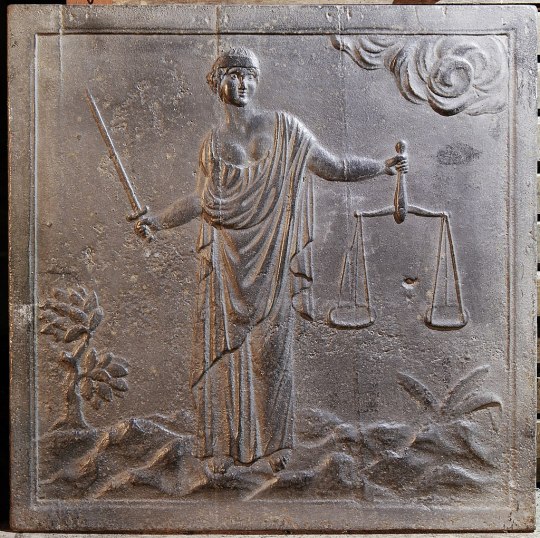
What does the scale, sword, crown, toga and blindfold represent?
The scale: represent weighing facts and evidence to decide a verdict. It also shows her duty to restore balance to society
The sword: represented authority in ancient times, and conveys the idea that justice can be swift and final.
The crown: its represent authority and strength
The toga: a Greco-Roman garment which symbolizes the status of the philosophical attitude that embodies justice.
The blindfold: Is intended to show Justice as blind to the injustice carried on before her, but it has been reinterpreted over time and is now understood to represent impartiality, the ideal that justice should be applied without regard to wealth, power, or other status.
So, how does it relate to the drama?
Its really nice to see a drama actually diving deeper into the meaning of her, especially questioning her role in the whole judicial system and why she looks the way she looks (also, the dramas focus on her in general is really nice- shes basically omnipresent all the time): Just like the drama, she is a rather ambiguous figure. Her appearance changes for who ever looks at her, her symbolism changes for who ever looks at her. For some, she is justice, for some she is nothing more than a chess figure.
(fun fact: i was able to figure out where the fountain is located not by the statue but by the small bit of the rooftops we see in the photo. umm... a german doing what we can do best: recognize german architecture haha)
Also, who ever has not yet looked at @onomatopagu-et-cie threads on this drama should definitely check them all out ♡
23 notes
·
View notes
Text



Alexander Robertus Todd was born on October 2nd 1907.
Our second Scottish Noble Laureate of the day, and indeed the second Glaswegian, Alexander was born in Cathcart in outer Glasgow, the son of Alexander Todd, a clerk with the Glasgow Subway, and his wife, Jane Lowry. Alexander Robertus Todd (Lord Todd) developed an interest in chemistry as an eight-year old while experimenting with iron filings from a toy chemistry set. Around four decades later, he was awarded the 1957 Nobel Prize in Chemistry and was ranked among the leading biochemists in the world.
He was educated at Allan Glen’s School and Glasgow University, where he took his B.Sc. degree in 1928 He received a PhD from Johann Wolfgang Goethe University of Frankfurt am Main in 1931 for his thesis on the chemistry of the bile acids. Todd was awarded an 1851 Research Fellowship from the Royal Commission for the Exhibition of 1851, and, after studying at Oriel College, Oxford, he gained another doctorate in 1933.
Todd returned to Scotland in 1934 when he joined the staff of Edinburgh University under G. Barger. Two years later, i.e. in 1936 he moved to the Lister Institute of Preventive Medicine, Chelsea, and became Reader in Biochemistry in the University of London in 1937.
In 1938 he was appointed as Sir Samuel Hall Professor of Chemistry and Director of the Chemical Laboratories of the University of Manchester, which position he held until 1944, when he accepted an appointment as Professor of Organic Chemistry at Cambridge University and Fellow of Christ’s College.
Todd’s honours are too numerous to mention in one article. From 1952 to 1964, he held the position of chairman of the advisory council on scientific policy to the British government. He was knighted as Sir Alexander Todd in 1954 for distinguished service to the government and was given a life peerage and named Lord Todd, Baron Todd of Trumpington in 1962. He was made a member of the Order of Merit in 1977. From 1975 to 1980, he served as the President of the Royal Society of Chemistry.
Lord Alexander Todd died at the age of 89 at his home in Cambridge on 10 January, 1997, following a heart attack.
Affectionately called Todd Almighty by his students, he was remembered by those who had known him as an outstanding scientist with an extraordinary memory and a great fondness for cigarettes.
2 notes
·
View notes
Text
Nur der Schallschutz bei Errichtung des Hauses muss eingehalten werden
1. Eine Mietwohnung, die in einem älteren, um das Jahr 1970 errichteten Gebäude liegt, weist – wenn nicht vertraglich etwas anderes vereinbart ist – in schallschutztechnischer Hinsicht keinen Mangel auf, sofern der Schallschutz den zur Zeit der Errichtung des Gebäudes geltenden DIN-Normen entspricht. 2. In einem Mehrfamilienhaus gelegentlich auftretende Lärmbeeinträchtigungen sind grundsätzlich…

View On WordPress
#33 C 644/21#AG Frankfurt/Main#Errichtung#Gebäude#Gericht#Haus#Lärmbelästigung#Mangel#Maßstab#Mehrfamilienhaus#Mietwohnung#Schallschutz#sozialadäquat#Störung#Urteil
0 notes
Text

Boeing 747-8i Lufthansa
Registration: D-ABYA Named: Brandenburg Type: 747-830 Engines: 4 × GE GEnx-2B67 Serial Number: 37827 First flight: Feb 8, 2012
Deutsche Lufthansa AG, commonly known as Lufthansa, is the largest German airline which, when combined with its subsidiaries, is the second-largest airline in Europe in terms of passengers carried. Lufthansa's registered office and corporate headquarters are in Cologne. The main operations base, called Lufthansa Aviation Center, is at Lufthansa's primary hub at Frankfurt Airport, and its secondary hub is at Munich Airport. The name is derived from the German word Luft meaning "air" and Hansa for the Hanseatic League. Lufthansa is one of the five founding members of Star Alliance, the world's largest airline alliance, formed in 1997. The company slogan is "Say yes to the world".
Poster for Aviators. aviaposter.com
9 notes
·
View notes
Text
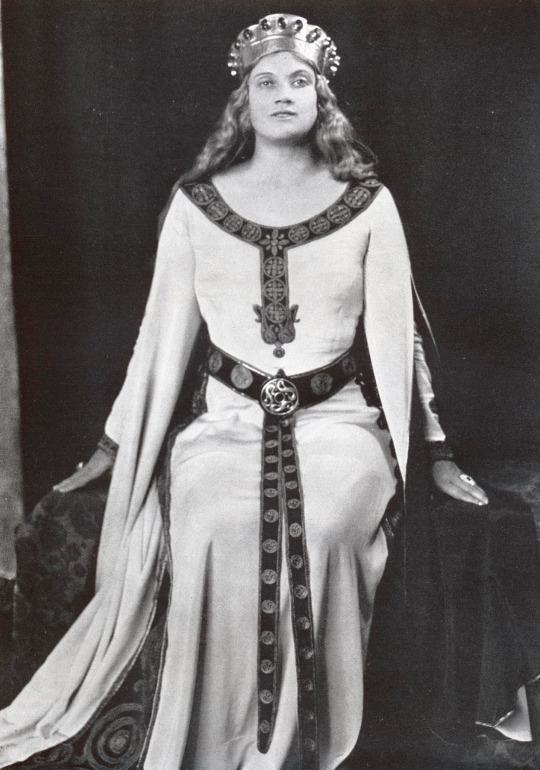
Dramatic Soprano Elisabeth Ohms was born on 17 May 1888 in Arnheim in The Netherlands. Her interest in music was evident at an early age, when she began studying violin and piano playing. She did not turn to singing until she was 28, getting her training at the conservatory in Amsterdam and in Frankfurt am Main. Her first engagement was at the Stadttheater in Mainz, but after just two years she joined the company of the Munich State Opera, where she remained for two decades. With Munich as a base, she went on extensive guest tours all over the world. One of her admirers was Arturo Toscanini, under whom she sang Kundry and Isolde in 1927 and 1929 at La Scala in Milan; another was Richard Strauss, who was especially enthusiastic about her Isolde. lt goes without saying that this fine Wagner soprano was heard in Bayreuth, too; Toscanini asked for her as Kundry when he conducted "Parsifal" for the first time there in 1931. Her appearances at the Metropolitan Opera in 1930 and 1931 were outstandingly successful. As an exception, she began with "Fidelio"; then came the Brünnhildes in the Ring, Ortrud and Venus, and finally, to crown her work there, Isolde. After these years of international successes, Elisabeth Ohm limited her sphere of activities to Munich, where she performed only rarely and ended her stage career in 1942. She then resided in Marquartstein, where she died on 16 October 1974. Gertrud Bindernagel was born on 11 January 1894 in Magdeburg. She studied at the conservatory in her home town and was only 17 when she was engaged by the local Stadttheater as a practical trainee. From 1913 to 1917 she continued her studies at the College of Music in Berlin. After finishing them she went to the opera house in Breslau, where she stayed until 1919. In 1919-20 she was with the Regensburg Stadttheater. From 1921 to 1927 she was a member of the company of the Berlin State Opera, where she scored enormous successes in a repertoire ranging from Nedda in "I pagliacci" to Isolde. From 1927 on, Gertrud Bindemagel was heard mainly at the Städtische Oper in Berlin; guest tours took her to Barcelona, Hamburg, Munich, Vienna and Mannheim. Following a performance of "Siegfried" at Berlin's Städtische Oper she was shot by her husband under the arcades of the opera hause. Domestic quarrels had led to the attack, from which she did not recover. She died of complications on 3 November 1932. Marta Fuchs, the celebrated high dramatic soprano of the 1930s and 40s, began her career as an alto in concerts. Born on 1 January 1898 in Stuttgart, she made her opera debut, after five years of concert work, at the Stadttheater in Aachen, still as an alto. Only in the course of her next engagement - with the Dresden State Opera beginning in 1930 - was her voice transformed into a high dramatic soprano. After 1935 she was also a member of the Berlin State Opera company and went on to become one of the most famous Wagner sopranos of the time. In 1933 she was already singing at the Bayreuth Festival, and until 1942 she was hailed by audiences there as Isolde, Kundry and especially Brünnhilde. In 1933 and 1935-37 she took part in Wagner performances in Amsterdam. In 1938 she sang Isolde at the Theatre des Champs-Elysees in Paris. In 1936 she was heard with the Dresden State Opera ensemble in London's Covent Garden as Donna Anna, the Marschallin in "Rosenkavalier", and Ariadne. In 1942 she was acclaimed at the Vienna State Opera. After 1945 Marta Fuchs lived in Stuttgart, giving only occasional guest performances and concerts. She died in Stuttgart on 22 September 1974. Anny Konetzni, bom on 12 February 1902 in Ungarisch-Weisskirchen, got her vocal training at the Vienna Conservatory, where her teacher was the renowned heroic tenor Erik Schmedes. Later she studied with Jacques Stückgold in Berlin. She began her singing career at the Vienna Volksoper (1925) with alto and mezzo roles, but the change to the big dramatic soprano parts was not long in coming.
#opera#classical music#music history#bel canto#composer#classical composer#aria#classical studies#soprano#Dramatic Soprano#Elisabeth Ohms#Ohms#La Scala#Teatro alla Scala#Metropolitan Opera#Met#Covent Garden#Royal Opera House#classical musician#classical musicians#classical history#historian of music#music theory#chest voice#diva#prima donna#maestro#Richard Wagner#Wagner#Paris Opera
12 notes
·
View notes
Text








[PAST_YEARS]_31102049 scharfenberg_g_portraits_timelines.file ///core:_ryder_von_scharfenberg.file\\\
⚠️ READ: Please do not repost/reupload any of my art here or to any other platform, or I will be forced to do anything to get it annihilated.
—
RYDER'S BACKSTORY (short version)
—
Ryder was born in Frankfurt am Main, Hesse, Germany on the 31st October 2049 with the given name Gilbert, into a wealthy Corpo family. Before he moved to the NUSA at the age of 16 together with his parents and an older brother, he lived a few years in Berlin where he came into contact with the Rave scene for the first time. He was raised in strong German Corpo manner from childhood on but he always felt he didn't belong in this life since he was never able to please his father, who is a high ranked businessman, nor do him any justice in fulfilling his tasks just right.
In 2070 nearly at the age of 21 his life reached a point where Ryder decided to finally set a cut and leave this toxic family for his own good. He was dealing with heavy depression for years, not being able to be who he wanted to be and felt like a failure leaving him with low self-esteem. Thanks to his interest in everything military Ryder stood in contact with an old Fourth Corporate War veteran living outside of the city, he met at a diner a few years prior. The old man offered him shelter for the time being before Ryder went back to live in the center. He was also offered to work for him. So he took jobs like protecting something of importance or kept thugs away together with a bunch of retired military officers but also civilians who didn’t want to deal with corporations like Militech and Kendachi anymore. During the next three and a half years Ryder also learned to shoot, different skills and tactics, all pathing the way for becoming a merc.
His entire look changed — he added tattoos and scarifications (to cover mostly scars his father gave him) and more cyberware to completely cut with his former Corpo life, and so he blended in with the middle class instead. During that time, in 2071, he ran into a guy named Vijay Steyr at a Depeche Mode Party. The two hit off with each other well and soon a relationship formed between them that lasted about a year. Their breakup had a reason with both sides agreeing it was better to stay friends instead. Ryder needed a bit more time to get over it, though, since he became very attached to Vijay, who plays an important role in Ryder’s life.
They rarely saw each other during that time with Ryder being mostly busy with his job anyway. In 2074 however, the contact with Vijay is thriving again and he gets offered to join Jackie’s and his team. From now on Ryder got stuck on Vijay again: they became best friends over the past few years and Jackie’s death in 2077 only fastened that bond.
One day Vijay starts talking about some guy he met and who he thinks is the Golden Demon of Kabuki and Ryder does not believe V, instead is making fun of it, because there are literally demons walking around in NC everywhere since it’s a fashion style. But after he gets to meet the mysterious guy who seems to surround his bestie all the time lately, even appearing at their jobs, he starts believing him. Ryder does not trust Arki at first. He can sense there’s something about the guy that is odd, but Vijay trusts him — and Ryder trusts V, so he accepts Arki with a certain grudge. Will these two Scorpios get along on the journey finding out about Arki’s past?
—
FYI: Ryder is my second created oc but not game V. I’ve always intended to make him a supportive character and love interest for Vijay since I was unhappy with the romance options until suddenly Arki jumped out of the dark bringing all the past events of cyberpunk 2077 already with him. Problem solved.
Thank you for reading. <3
#cyberpunk 2077#male v#masc v#oc: ryder von scharfenberg#past days: 2066#past days: 2069#past days: 2071#cyberpunk oc#cyberpunk v#virtual photography#leaving corpo life behind did well to him <3
36 notes
·
View notes
Text
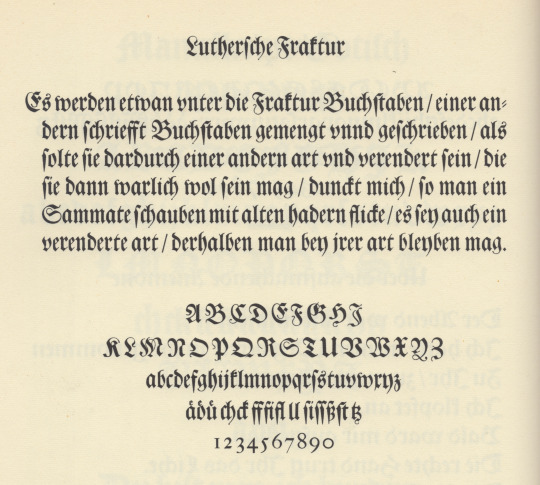

luthersche fraktur
first illustration is from plate 122 in jan tschichold’s excellent source book Meisterbuch der Schrift [otto maier verlag, ravensburg, 2nd ed., 1965]. in the note to the plate tschichold tells us [translation mine]: «Fraktur, the script of the German Renaissance, was utilized unchanged in the baroque until into the rococo. The example before us, a cut originating with the famous, ancient Frankfurt type-foundry Egenolff-Luther, is the most noble of still available ancient fraktur types. The plate shows the gorgeous Text-size, which first turned up in 1708 on an Augsburg type specimen. The typeface now belongs to the type-foundry D. Stempel AG in Frankfurt am Main.» text-size is the old founders’ specification for a casting-mould (body-size) of approximately twenty didot points—approximately twenty-four english-american points. i always read tschichold as gospel, but why does tschichold refer to «the 1708 specimen»—publisher‘s name? the text-size certainly appears on the 1678 luther foundry fraktur-specimen.
second illustration is a section from Fraktur-Schriftprobe des Schriftgießers Johann Erasmus Luther, Frankfurt a. M. 1678 [plate 9 in Frankfurter Schriftproben aus dem 16. bis 18. Jahrhundert, d. stempel ag, frankfurt am main, 1955]. in his introduction to the folio, dr robert diehl notes [translation mine]: «However, also a new proprietary cut of fraktur face was begun under the directorship of Erasmus Luther. It became known by the name Luther fraktur, and was later recut & reissued by the type foundry D. Stempel AG in Frankfurt.» [ibid., introduction, p4]. stempel acquired the type- foundry department of w. drugulin, the famous leipzig printing company, in 1919; & drugulin held matrices of original luther fraktur. stempel issued its luthersche fraktur revival that same year.
7 notes
·
View notes
Text
Anne Franks legacy inspires Manchester book appeal
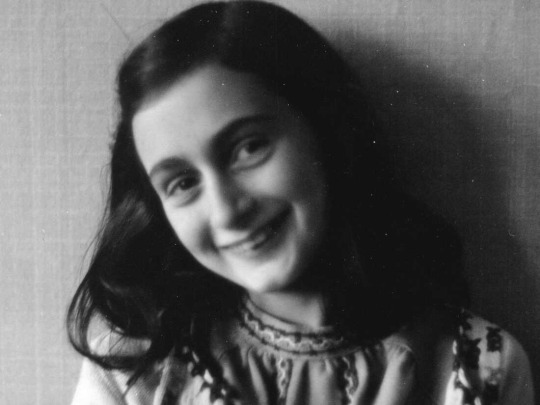
Have you ever read Anne Franks diary? Thanks to Maurice from West Didsbury, we’ve been back to the Wood Street Mission in Manchester, with copies of Anne Frank’s diary, which Maurice kindly donated to the ’Books Forever Appeal’.
Anne Frank was born in the German city of Frankfurt am Main in 1929. On her thirteenth birthday, just before Anne’s family went into hiding in NAZI occupied Amsterdam, Anne Frank was presented with a diary.
During the two years in hiding, Anne wrote about events in the Secret Annex, but also shared her thoughts and feelings. Writing also helped Anne document her experiences, of being a young Jewish woman in hiding from Hitler’s Third Reich.
Anne Frank had planned to publish a book about her time in the Secret Annex. After World War Two ended, her father Otto Frank fulfilled her wish and since then, Anne Frank’s diary has been translated into more than 70 languages.
Here in Manchester, at the St Johns Garden in the city centre, the Anne Frank tree was planted on June 12th 1998. The tree serves as a lasting memorial to Anne Frank and all children killed in wars and conflicts since WW2.
In 2013, a rose dedicated to Anne Frank was also planted at the Manchester Jewish Museum, to mark Holocaust Memorial Day. The rose planted had been grafted from one made in the year of Anne’s birth in 1929, and another from the year of her death in 1945.
What also makes this donation from Maurice meaningful, is that the city of Manchester is home to some of the children and grandchildren of those British soldiers, who as liberators of the Bergen-Belsen Concentration Camp, bore witness to where Anne Frank lost her life.
Anne Frank wrote in her diary; “where there’s hope, there’s life. It fills us with fresh courage and makes us strong again.” Anne also wrote; “how lovely to think that no one need wait a moment, we can start now, start slowly changing the world.”
For more information, please visit WoodStreetMission.org.uk or to donate new books for children aged 0-16 years, please send them to Wood Street Mission, 26 Wood Street, Manchester, M3 3EF, The UK.
#anne frank#Anne Frank House#diary of anne frank#wood street mission#manchester#books forever appeal#books forever#books#writing#authors#book club#uk news#ww2 history#holocaust education#uk#waterstones#Holocaust Memorial Day
5 notes
·
View notes